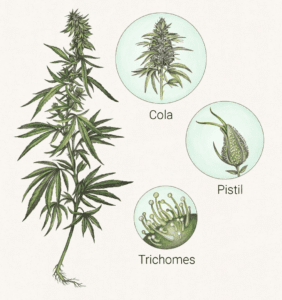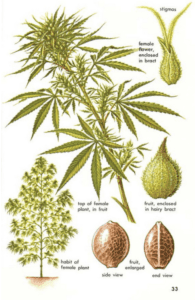The Demystification of Basic Cannabis Anatomy and Vocabulary
Like any other kind of expert, botanists use a specialized, fairly jargony vocabulary to describe their field of study. This industry-specific lingo allows botanists to quickly convey information to informed plant enthusiasts and other experts in their field; however, it can be a bit tricky for your average layman to decode. Just check out the following description of the cannabis plant from Wikipedia to see what we mean:
“Cannabis is an annual, dioecious, flowering herb. The leaves are palmately compound…with serrate leaflets. Cannabis normally has imperfect flowers, with staminate ‘male’ and pistillate ‘female’ flowers occurring on separate plants.”
That brief, two-sentence description conveys a wealth of useful information about how the plant looks, but without context you might (understandably) be a little lost – and nobody really has time to click twelve links just to understand what a plant looks like. And here’s where it gets even crazier – this encyclopedic definition contains just a select few of the botanical words that you may have heard associated with cannabis! We’ve put together some layman’s definitions of botanical terms that are often used to describe or explain cannabis anatomy, in the hopes that it help save you some headache when you’re doing more research into the science of our favorite plant! (Don’t worry – there’s no test at the end.)

Annual – This means that the plant completes a full life cycle within one growing season. Cannabis is one example, corn is another.
Apical or Terminal Bud – This is the top of the plant. On the cannabis plant, these will typically be the biggest, most potent buds. They are often referred to as ‘colas’.
Axil & Axillary Bud – This is the place on the plant where leaves meet the main stem. In cannabis plants, these have special cells that will grow into either side branches or flowers.
Dioecious – This comes from Latin and literally means ‘two houses’. This means that cannabis can have either female or male flowers on separate plants. Non-pollinated female flowers are what end up in your bowl or joint!
Flower – With most plants, flowers are colored brightly and prettily to attract pollinators; in weed, the flowers are pretty for a different reason, and the terpenes the plant produces do the work of attracting the right pollinators. As you probably know, the female flowers of cannabis plants produce THC (and a plethora of other cannabinoids) in much higher concentrations than other parts of the plant. Fun trivia: neither the male nor female cannabis flower has petals!
Floral Bud – This is an axillary bud that has gotten the chemical signals to begin flowering. Eventually, this becomes smokable cannabis.
Herbaceous – This means that the cannabis plant doesn’t get woody or extremely fibrous. Instead, the stem stays green and relatively flexible.
Lateral Shoot – This is a branch that used to be an axillary bud (see a pattern developing here?)
Leaf – The main location for energy production in most plants – and cannabis is no exception. On the cannabis plant, the leaves are palmately compound, meaning the leaves are split into tinier leaflets which radiate from a central point.
Petiole – The little stalk that holds the main blade of the leaf or leaflets.
Rachis – The point at which all of the leaflets meet. They can also get a little stretched and look like little petioles themselves.
Stem – The part of the plant that supports and gives rise to leaves and flowers; it joins the root system at the soil level.

And that’s it as far as cannabis anatomy goes. You now know everything about the cannabis plant, and there’s nothing more to say. Well – of course there is, but we think that after all this learning, it’s time to go enjoy some cannabis of your own!
Sources:
Lebel-Hardenack, Sabine; Grant, Sarah R. (1997). “Genetics of sex determination in flowering plants”. Trends in Plant Science 2 (4): 130–6.doi:10.1016/S1360-1385(97)01012-1
http://en.wikipedia.org/wiki/Cannabis
Photo credits: Howard G Charing / CC BY-NC / https://ocs.ca/blogs/cannabis-anatomy/the-cannabis-plant-1 / ocs.ca